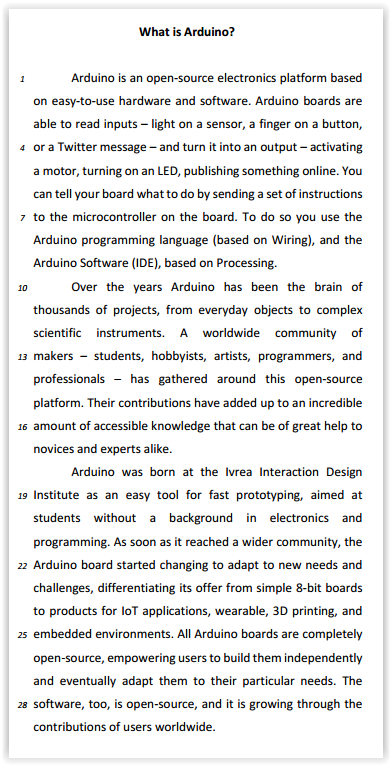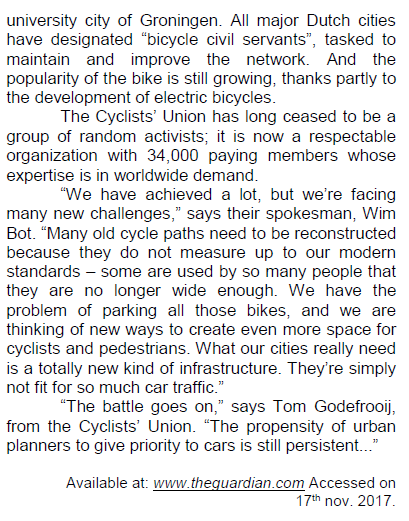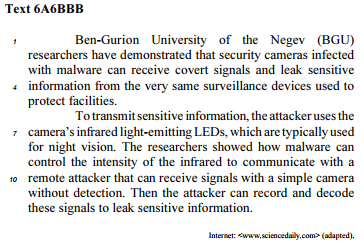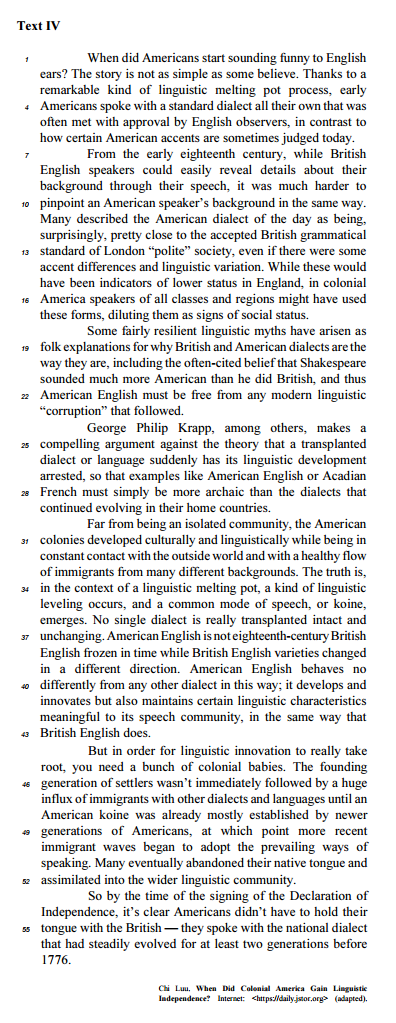
Decide whether the following statements are right (C) or wrong (E) according to text IV.
The author criticizes Krapp's argument that exemplars of transplanted languages or dialects such as Acadian French are more archaic than the original ones, which continued evolving in their home countries.
A questão refere-se ao texto seguinte:
Esse texto é uma carta de uma leitora publicada na “Teen Ink”, uma revista mensal que divulga textos e trabalhos de arte de adolescentes. Na carta, a autora critica:
A questão refere-se ao texto seguinte:
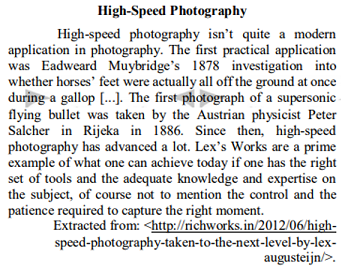
Check the correct alternative according to the text.
“If the car maker you were thinking of going with, like Toyota, for instance, isn't on the list, don't change your car-buying plans just for this software.” In the sentence above, we can comprehend that: Read the text and answer the following two questions. “If you invite me to your wedding or hen party, you’ll handle me in one of three ways. One: you brief everyone, so there’s no chance they’ll ask about my relationship status. Two: you shoot me a sympathetic glance when something romantic happens and tell me how tired you are of wedding planning. Three: you don’t acknowledge my divorce at all, and treat me exactly the same as every other guest. The third is my favorite. The world already gives me ample reminders that I am different from most people my age. I was married at 23, divorced by 25. Some of you were at the wedding and have no doubt revisited that day, searching for clues that the marriage was doomed. It turns out there were none; everything was wrong from the start, but we were all too young to notice, or too polite to point it out. I spent years justifying my decision to continue with the relationship. We had stopped making time for each other, and he paid very little attention to me on our wedding day. But we’d been together six years and romance doesn’t last forever, does it? The best of you were supportive when I repeated this mantra, but there was enough skepticism in your expression to push me to start questioning it.” (theguardian.com)
Text 3A7AAA
Software architecture is a complex topic. Due to its
complexity, our profession has produced a variety of definitions,
each more or less useful depending on your point of view. Here is
a definition from my first book, Journey of the Software
Professional: "A system architecture defines the basic "structure"
of the system (e.g., the high level modules comprising the major
functions of the system, the management and distribution of data,
the kind and style of its user interface, what platform(s) will it run
on and so forth)".
This definition is pretty consistent with many others.
However, it lacks some important elements, such as specific
technology choices and the required capabilities of the desired
system. A colleague of mine, Myron Ahn, created the following
definition of software architecture. It is a bit more expansive and
covers a bit more ground than my original: "Software architecture
is the sum of the nontrivial modules, processes, and data of the
system, their structure and exact relationships to each other, how
they can be and are expected to be extended and modified, and on
which technologies they depend, from which one can deduce the
exact capabilities and flexibilities of the system, and from which
one can form a plan for the implementation or modification of the
system".
We could extend these definitions from the technical point
of view, but this wouldn't provide a lot of value. More than any
other aspect of the system, architecture deals with the "big picture".
The real key to understanding it is to adopt this big picture.
Moreover, while these definitions are useful, they are far too
simplistic to take into account the full set of forces that shape, and
are shaped by, an architecture. In truth, I doubt that any single
definition of software architecture will ever capture all of what we
believe to be important.
Luke Hohmann. Defining software architecture. In: Beyond
software architecture: creating and sustaining winning
solutions. Boston: Addison-Wesley, 2003, p. 1-2 (adapted)
The author of text 3A7AAA concludes that
Cultures that value group harmony tend to avoid public disagreement.
The text suggests finding a mediator or assigning responsibility to all group members to solve problems.
Judge the item that follow according to the text above.
A part of Arduino’s boards is free and another part is charged for.
Das afirmações seguintes: I. In King’s imagined nation, there was equal justice for none. II. Maya Angelou is an American singer. III. Maya Angelou believes hate and racism no longer exist in the United States.
Read the sentences about the text:
I. At the start of the past century the use of bikes lessened around 6% every year.
II. In the decade of 60 two factors colaborated to the nowadays status of the cycling in Amsterdam.
III. More than ¼ of the trips are made by bicycle. In the US this percentage reached just 2%.
IV. Parking a bike is not a problem in the capital of this transportation.
Read the fragment:
“The factors affecting the language learning situation may also affect the extent to which the learner chooses to identify with the culture. Like the learning process, this identification is a dynamic process that may change over time according to the social and interactive aspects of the individual learner's experience." (Pena, Cristina Becker Lopes, BELT, 2015)
In this context, the author also develops that:
I - “Individuals build their identities through language and, as second language learners, often find themselves having to build another one through the new language and the sociocultural lens of the second language context;
II - This should not lead to unintentional misperceptions when performance involves language errors and misunderstandings, it also reflecting by culture and society during the learning process;
III - Moreover, given the complex nature of sociocultural and political identities of a given nation, certain identities may be imposed on a learner due to social aspects such as power relations or inequalities of various types." (Pena, Cristina Becker Lopes, BELT, 2015)
It is correct what is written on option:
Based on text, an adapted forum discussion, answer question below.


The main purpose of this blog article is to:
Based on text, an adapted forum discussion, answer question below.


According to the text, Jake thinks that:
Based on text, an adapted forum discussion, answer question below.


Mila's sentence “Can you give more examples of “frameworks'?" could be written in reported speech as:




